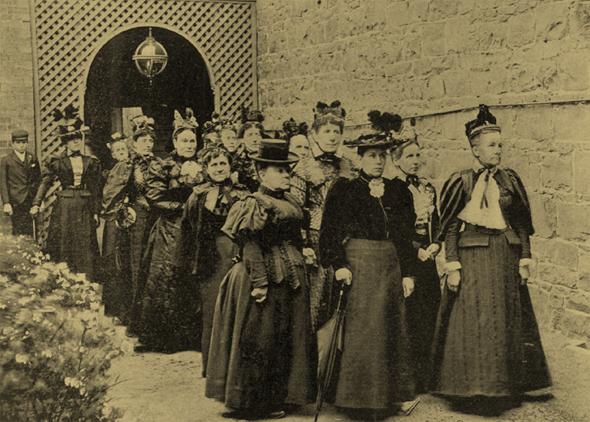Description
This black-and-white photograph taken on 6 September 1898 shows 13 suffragettes, posed in ranks of three, about to march on the Parliament of the colony of Victoria. It was published in the Australasian on 17 September 1898. The photograph's caption (not shown) reads 'VANGUARD OF THE DEPUTATION THAT WAITED ON MEMBERS OF THE LEGISLATIVE COUNCIL LAST WEEK, ADVANCING FROM HEADQUARTERS IN RUSSELL STREET'.
![]() Further information is available for this resource.
Further information is available for this resource.
Educational value
- The group in the photograph was among a large deputation who lobbied members of the Victorian Legislative Council to urge them to pass the 1898 Women's Franchise Bill, which was before the Council at the time. Known as 'suffragettes', the women believed that they and other women were entitled to the vote (also known as the suffrage or franchise). The only way they could gain the vote was for the Victorian Parliament to pass a new franchise law.
- Women in Victoria had been engaged in the struggle to gain the vote for many years. The Victorian Women's Suffrage Society had been founded in 1884, and the first female suffrage bill had been introduced into the Victorian Parliament in 1889. It and all subsequent bills had failed. Even the 'monster petition' for female suffrage presented to Parliament in 1891 with 30,000 female signatures failed to convince the all-male members to grant women the vote.
- Marches and deputations to lobby members of Parliament were common strategies to gain public attention and seek the support of members, but some of the women in the deputation apparently went further. According to an accompanying article in the Australasian, 200-300 women invaded the clubroom of the Legislative Council, surprising the members as they relaxed in private and presenting their arguments for the franchise face-to-face.
- The women in the deputation targeted their action at members of the Legislative Council, the upper house of the Victorian Parliament, where women's franchise bills had been blocked in the past and would be again. The Council was highly conservative and a majority of members believed that granting women the right to vote would lead to women abandoning their domestic duties and failing to look after their children, a rise in the divorce rate and a drop in the birthrate.
- It is likely that the photograph includes the activists Jane Fryer and Annie Lowe, members of the religious group the Society of Friends (Quakers). Both Fryer and Lowe spoke for the women in the Legislative Council clubroom. Fryer was a political and religious radical activist for a wide range of causes. Lowe was one of the founders of the Victorian Women's Suffrage Society. Quakers believed in the equality of men and women and actively supported female suffrage.
- Like the ten previous bills, the 1898 Bill was rejected in the Legislative Council and the women's actions failed. Nineteen bills were presented before Victorian women gained the right to vote in state elections in 1908. That was 14 years after South Australian women had gained the vote and seven years after Victorian women had gained the vote in federal elections. Victoria was the last state in Australia to extend the state franchise to women.
